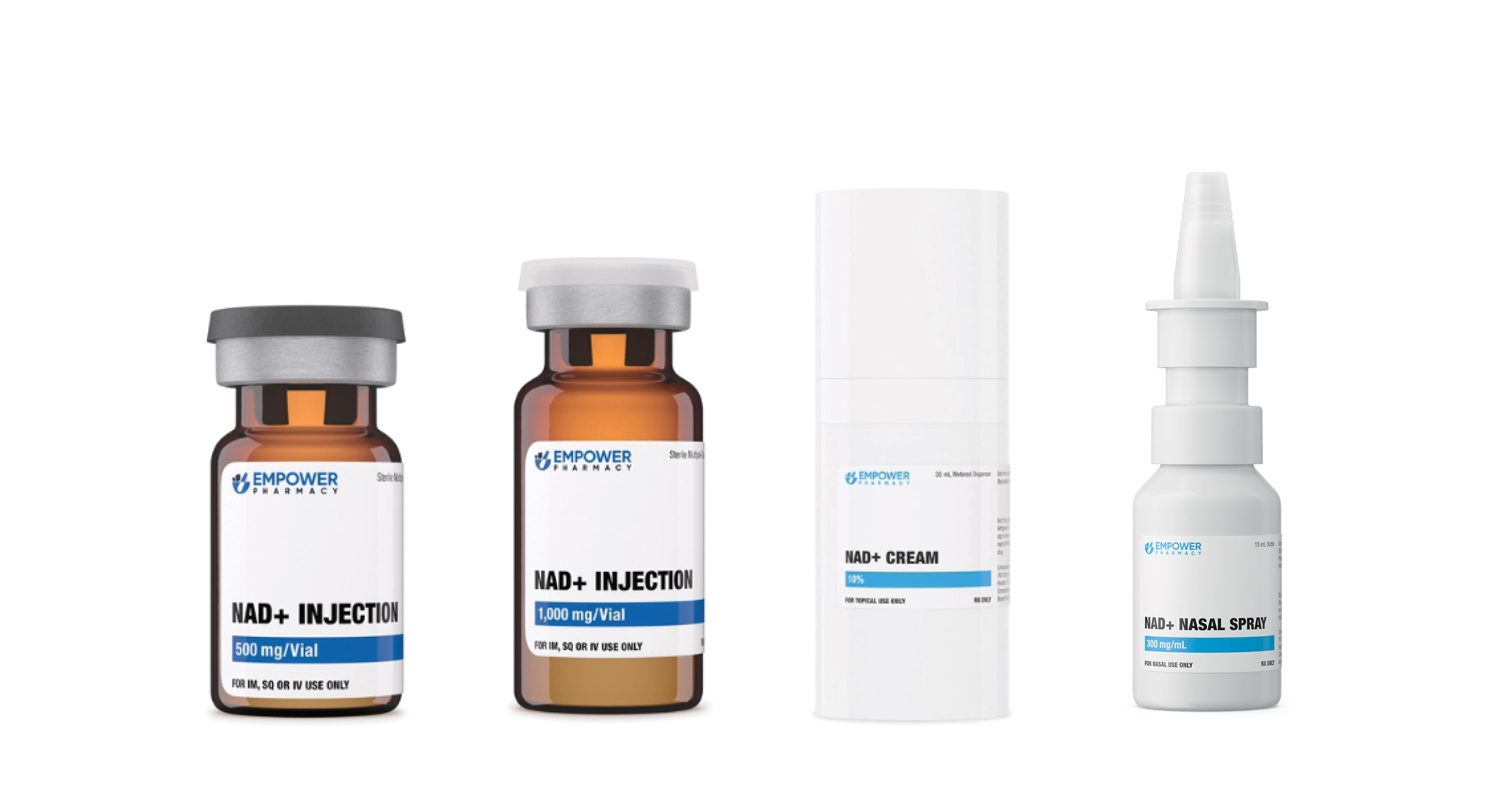Article Summary
NAD+ is vital for cellular processes like DNA repair and energy metabolism. Its deficiency can impact immunity, cognition, and even heart function. IV NAD+ therapy shows promise in treating addiction, enhancing cognition, managing chronic fatigue, improving athletic performance, and potentially aiding in pain management.General Information on NAD+
First discovered in the early eighteenth century, Nicotinamide Adenine Dinucleotide (NAD) is an essential ingredient in metabolic processes and reactions that occur in cells within the human body. All significant cellular events within the human body cannot occur without the presence of NAD. Examples of some processes that are dependent on NAD are glycolysis (the breakdown of glucose into pyruvate and hydrogen), citric acid or tricarboxylic acid cycle (the release of stored energy from carbohydrates, proteins, and fats through the oxidation of acetyl CoA), the oxidation or breakdown of fatty acids, DNA repair, inflammatory responses, among many other processes. NAD usually undergoes either oxidation or reduction as it exerts its effects on the body’s metabolic processes; the oxidized variant of NAD is referred to as NAD+.[1][2]
How NAD+ is Synthesized
There are two primary mechanisms by which NAD+ is synthesized in the human body. One of the pathways for NAD+ synthesis is the kynurenine pathway, whereby NAD+ is synthesized from the essential amino acid tryptophan. In this pathway, tryptophan undergoes a process known as oxidative cleavage to form the product formylkynurenine; this process is facilitated by the enzymes tryptophan-2, 3-dioxygenase (TDO), and indoleamine-2, 3-dioxygenase (IDO). Further enzymatic reactions occur after the formation of formylkynurenine and it is then converted into NAD+ using several enzymes, one of which is 3-hydroxyanthranilic acid 3, 4-dioxygenase (3-HAAO).[3]
The second pathway for NAD+ synthesis is known as the salvage pathway. The salvage pathway is so named because NAD+ is recycled during the consumption of nicotinic acid, nicotine adenine mononucleotide, and nicotinamide. The enzyme nicotinamide phosphoribosyltransferase (Nampt) converts nicotinamide to nicotinamide adenine mononucleotide (NMN) and is then converted into NAD+ using another enzyme known as nicotinamide mononucleotide adenylyltransferase (Nmnat). Alternatively, nicotinic acid may be used as a precursor for NAD+ synthesis; nicotinic acid mononucleotide (NAMN) is generated from nicotinic acid, which is then conjugated to NAD+ using the enzyme Nampt. The variety of pathways available for the synthesis of NAD+ is a reflection of its importance within the human body.[4]
Importance of NAD+ In the Human Body
As stated earlier, NAD+ is crucial for a number of key physiological processes within the human body. A deficiency in NAD+, or a disruption in NAD+ homeostasis in the body, may impair these physiologic processes, which may result in different illnesses or disease conditions. Discussed below are some of the many physiologic processes that are dependent on NAD+.[1][5][6][7]
1. Genomic Stability
On a daily basis, reactive oxygen species (ROS) and reactive nitrogen species (RNS) are released endogenously within the body; these substances cause damage to cellular DNA. In addition, exogenous factors such as carcinogens, chemical mutagens, as well as radiation may also result in cellular DNA damage. When cellular DNA damage occurs due to either endogenous or exogenous factors, genomic instability occurs, which may result in cancer development and an increased rate of cellular aging.
In order to minimize cellular DNA damage and its consequences, there is a process in the body known as DNA-damage response (DDR). DDR is a process that detects and repairs any damaged DNA in the body. DDR is a process that is highly dependent on NAD+; when amounts of NAD+ are low in the body, the DDR process is impaired, resulting in increased damage to the cellular DNA.
2. Genetic Expression
The means by which genetic information in cellular DNA is used to produce the relevant proteins or substances in the human body is known as genetic expression. Genetic expression is the process that is responsible for the development of all the physical features that define an individual, such as hair and skin color, among other physical characteristics.
One of the mechanisms by which genetic expression successfully occurs in the body is through modifying a product known as histones. Histone modification is a NAD+ dependent process; a deficiency in NAD+ levels may disrupt histone modification, which may impair genetic expression. NAD+ deficiency may also result in the methylation of cellular DNA so that genes are not expressed appropriately; this is known as genetic silencing.
3. Immunity and Inflammation
Studies have shown that NAD+ levels in the human body determine the extent as well as the effectiveness of immune responses during infection. Increased levels of NAD+ during an infection increase oxidative phosphorylation in macrophages, which makes them better able to neutralize the organism causing the infection.
In addition to the increased expression of macrophages, NAD+ also exerts anti-inflammatory effects during an infectious process. Studies have shown that the expression of inflammatory markers such as Tumor Necrosis Factor alpha (TNF-a) and Interleukin-6 (IL-6) significantly diminish when there are high cellular levels of NAD+ and its precursors.
4. Energy Metabolism
Several metabolic pathways in the human body result in the release of energy. Some examples of the energy metabolic pathways are glycolysis, tricarboxylic acid (Krebs) cycle, oxidative phosphorylation, fatty acid oxidation, and ethanol metabolism. All the energy metabolic pathways require the presence of NAD+ as a coenzyme to function properly. In the glycolytic pathway, NAD+ facilitates the catalytic reactions of Glyceraldehyde-3-phosphate dehydrogenase (GADPH) and lactate dehydrogenase (LDH). In the Krebs cycle, NAD+ functions as a coenzyme for the rate-limiting enzymes alpha ketoglutarate dehydrogenase, isocitrate dehydrogenase, and malate dehydrogenase. Alcohol metabolism, which occurs in liver cells, also requires NAD+ as a cofactor for the process’s successful execution. A deficiency of NAD+ in the body may impact all these processes and negatively impact the effectiveness by which energy is generated and utilized by the body.
5. Circadian Clock
The circadian clock, also known as the biological clock or circadian rhythm, is an internal endogenous process that regulates the sleep-wake cycle in the human body. This internal clock helps the body adjust to different times of the day or the different seasons. The accuracy and effectiveness of the circadian clock are due in part to cellular levels of NAD+. A deficiency of NAD+ may disrupt the circadian rhythm and result in effects such as daytime sleepiness, restless sleep, hormonal imbalances, and mood alterations, among others.
6. Cardiovascular Function
The heart is the most metabolically active organ in the human body because it is constantly beating. Studies have shown that normal NAD+ levels are essential in maintaining the metabolic activity of the heart. Furthermore, in the event of a significant cardiac event such as a transient ischemic attack or myocardial infarction, normal levels of NAD+ help in the recovery from injury. Other studies have shown that a deficiency in NAD+ may result in cardiac disorders such as cardiac hypertrophy and fibrosis.
7. Kidney Function
Generally, renal function has a tendency to decrease as people get older. It is suspected that reduced levels of NAD+ in the elderly may have a role to play in the reduction in renal function. Research has indicated increased protection against acute renal injury when individuals were given NAD+ supplements. In addition, NAD+ supplements stimulated the release of prostaglandin E2, which serves to improve renal function after an acute renal injury.
8. Liver Function
Normal NAD+ levels in the body are essential for the optimal functioning of the liver. Specific enzymes in the NAD+ pathways protect the liver from conditions such as hepatic fibrosis, nonalcoholic fatty liver disease, and nonalcoholic steatohepatitis. Several studies have been performed that show that giving individuals NAD+ supplements may boost the liver’s overall health, protect it from toxic illnesses, and enhance its capacity for regeneration after a hepatic injury.
9. Neurological Function
NAD+ and its precursors have been shown to have a protective effect on the neurons in the brain after a significant neurological event such as a stroke. Having normal levels of NAD+ in the body is essential to the normal functioning and survival of cerebral neurons. Additionally, NAD+ supplements have shown some benefits in treating and preventing some neurodegenerative diseases such as Alzheimer’s disease; this is not definite, however, and there are several ongoing studies still exploring this possibility.
Benefits of IV NAD+ Therapy
Given the integral role that NAD+ plays in all the body’s major processes as detailed in the previous section, it is essential to ensure that NAD+ levels are optimal. If there are signs of NAD+ deficiency, such as in pellagra, which manifests as dermatitis, dementia, or diarrhea, supplemental IV NAD therapy may be warranted. In addition to signs of NAD+ deficiency, there are other reasons for which an individual may consider receiving intravenous NAD+ supplementation; some of these reasons include the following:
1. Addiction Therapy
One of the most common reasons why IV NAD+ therapy may be considered in some individuals is in the management of addiction. IV NAD+ may benefit patients weaning off opioid, alcohol, chemical, or prescription drug dependencies; it may also serve to minimize the severity of withdrawal symptoms. While the mechanism of how NAD+ works in this regard is still under investigation, it is believed that IV NAD+ helps flush drugs out of the body and reduce cravings.
2. Improved Cognition
As has previously been stated, NAD+ has been shown to exert both protective and stimulatory effects on the brain. For this reason, IV NAD+ therapy may be administered to potentially enhance memory, improve concentration, improve the ability to focus, enhance brain regeneration, and improve overall neurological function. Studies are still ongoing regarding the precise means by which exogenous NAD+ supplementation exerts these effects.
3. Chronic Fatigue
IV NAD+ therapy has been used in the management of individuals with chronic fatigue and low energy levels. NAD+ is an essential cofactor in the glycolytic pathway and tricarboxylic acid pathways; these pathways result in Adenosine Triphosphate (ATP) production, which is the energy source of the human body. Through exogenous NAD+ supplementation, ATP levels in the body are increased which may have a resulting effect in boosting energy levels and reducing feelings of fatigue.
4. Athletic Performance
Due to its role in ATP production, some athletes have used IV NAD+ therapy to enhance their athletic capabilities and performance. IV NAD+ supplements may boost energy levels, improve cognition, and increase reaction times in athletes during competitions or other athletic events. In addition, studies have shown that NAD+ supplementation may assist in muscle development as well as muscle repair, leading to muscle hypertrophy and muscle hyperplasia.
5. Pain Management
One of the more novel reasons why some individuals receive IV NAD+ therapy is in managing pain. NAD+ is known to exert significant anti-inflammatory actions within body and may be used to reduce the inflammation that typically occurs with pain and, thereby, offer some relief from pain. Studies into the use of supplemental NAD+ as a form of pain control are still ongoing and the results so far are not yet definitive.
Looking to source 503A longevity products for your patients?
Set up your Empower Pharmacy account today to get started.
Looking to source 503B IV therapy products for your practice?
Set up your Empower Pharma account today to get started.
*Compounded medications are not approved by the FDA and are not tested by the FDA for safety and efficacy.
- Xie, N., Zhang, L., Gao, W., Huang, C., Huber, P.E., Zhou, X., Li, C., Shen, G., Zou, Bingwen,” NAD+ metabolism: pathophysiologic mechanisms and therapeutic potential”, Signal Transduction and Targeted Therapy. October 2020. Available: https://www.nature.com/articles/s41392-020-00311-7
- Bockwoldt, M., Dorothée, H., Niere, M., Gossmann, T.I., Reinartz, I., Schug, A., Ziegler, M., Heiland, I., “Identification of evolutionary and kinetic drivers of NAD-dependent signaling”, Proceedings of the National Academy of Sciences of the United States of America, vol. 116 issue 32, pp. 15957-15966. Available: https://www.pnas.org/content/116/32/15957
- Badawy, A.A., “Kynurenine Pathway of Tryptophan Metabolism: Regulatory and Functional Aspects”, International Journal of Tryptophan Research. March 2017. Available: https://www.ncbi.nlm.nih.gov/pmc/articles/PMC5398323/
- Yaku, k., Okabe, K., Hikosaka, K., Nakagawa, T., “NAD Metabolism in Cancer Therapeutics”, Frontiers in Oncology. December 2018. Available: https://www.ncbi.nlm.nih.gov/pmc/articles/PMC6315198/
- Xie, N., Zhang, L., Gao, W., Huang, C., Huber, P.E., Zhou, X., Li, C., Shen, G., Zou, Bingwen,” NAD+ metabolism: pathophysiologic mechanisms and therapeutic potential”, Signal Transduction and Targeted Therapy. October 2020. Available: https://www.nature.com/articles/s41392-020-00311-7
- Rajman, L., Chwalek, K., Sinclair, D.A., “Therapeutic potential of NAD-boosting molecules: the in vivo evidence”, Cell Metabolism, vol. 27 issue 3, pp. 529 – 547. Available: https://www.ncbi.nlm.nih.gov/pmc/articles/PMC6342515/
- About NAD, “Improving NAD Status to Support Cellular Resilience”. Available: https://www.aboutnad.com/nad-benefits
- Mehmel, M., Jovanovi, N., Spitz, U., “Nicotinamide Riboside—The Current State of Research and Therapeutic Uses”, Nutrients, vol.12 issue 6, pp. 1616. Available: https://www.ncbi.nlm.nih.gov/pmc/articles/PMC7352172/




